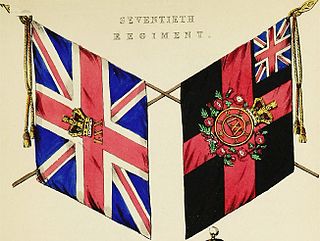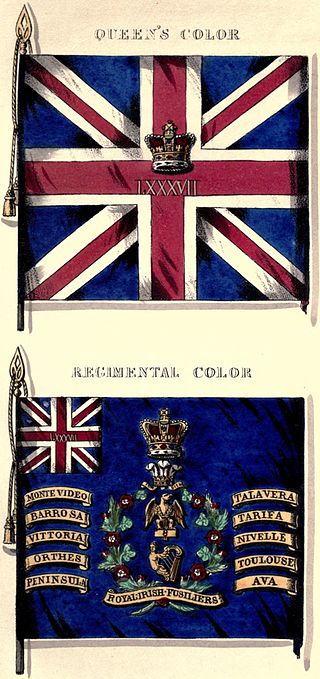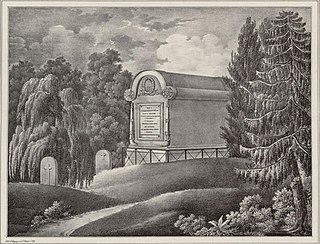Related Research Articles

Barrimore Matthew "Barry" St. Leger was a British Army officer. St. Leger was active in the Saratoga Campaign, commanding an invasion force that unsuccessfully besieged Fort Stanwix. St. Leger remained on the frontier for the duration of the war; after its conclusion, he served briefly as commander of British forces in Quebec.

The 88th Regiment of Foot (Connaught Rangers) was an infantry Regiment of the British Army, raised in 1793. Under the Childers Reforms it amalgamated with the 94th Regiment of Foot to form the Connaught Rangers in 1881.

The 50th Regiment of Foot was an infantry regiment of the British Army, raised in 1755. Under the Childers Reforms it amalgamated with the 97th Regiment of Foot to form the Queen's Own Royal West Kent Regiment in 1881.

The 73rd Regiment of Foot was an infantry regiment of the British Army, raised in 1780. Under the Childers Reforms it amalgamated with the 42nd Regiment of Foot to form the Black Watch in 1881.
The 84th Regiment of Foot was a regiment in the British Army, raised in 1793. Under the Childers Reforms it amalgamated with the 65th Regiment of Foot to form the York and Lancaster Regiment, with the 84th becoming the 2nd Battalion, in 1881.
The 65th Regiment of Foot was an infantry regiment of the British Army, raised in 1756 as the 2nd Battalion, 12th Regiment of Foot. Under the Childers Reforms it amalgamated with the 84th Regiment of Foot to become the 1st Battalion, York and Lancaster Regiment in 1881.

The 70th (Surrey) Regiment of Foot was a regiment of the British Army, raised in 1756. Under the Childers Reforms it amalgamated with the 31st (Huntingdonshire) Regiment of Foot to form the East Surrey Regiment in 1881.

The 31st (Huntingdonshire) Regiment of Foot was an infantry regiment of the British Army, raised in 1702. Under the Childers Reforms it amalgamated with the 70th (Surrey) Regiment of Foot to form the East Surrey Regiment in 1881.
The 66th (Berkshire) Regiment of Foot was an infantry regiment of the British Army, raised in 1756. Under the Childers Reforms it amalgamated with the 49th (Hertfordshire) Regiment of Foot to form the Princess Charlotte of Wales's in 1881.
The 69th Regiment of Foot was an infantry regiment of the British Army, raised in 1756. Under the Childers Reforms it amalgamated with the 41st (Welch) Regiment of Foot to form the Welch Regiment in 1881.
The 41st (Welch) Regiment of Foot was an infantry regiment of the British Army, raised in 1719. Under the Childers Reforms it amalgamated with the 69th Regiment of Foot to form the Welch Regiment in 1881.
The 80th Regiment of Foot (Staffordshire Volunteers) was an infantry regiment of the British Army, raised in 1793. Under the Childers Reforms it amalgamated with the 38th (1st Staffordshire) Regiment of Foot to form the South Staffordshire Regiment in 1881.

The 81st Regiment of Foot (Loyal Lincoln Volunteers) was an infantry regiment of the British Army, raised in 1793. Under the Childers Reforms it amalgamated with the 47th (Lancashire) Regiment of Foot to form the Loyal North Lancashire Regiment in 1881.

The 87th Regiment of Foot was an infantry regiment of the British Army, raised in 1793. Under the Childers Reforms it amalgamated with the 89th Regiment of Foot to form the Princess Victoria's in 1881.

The 86th Regiment of Foot was an infantry regiment of the British Army, raised in 1793. Under the Childers Reforms it amalgamated with the 83rd Regiment of Foot to form the Royal Irish Rifles in 1881.
The 107th Regiment of Foot (Queen's Own Royal Regiment of British Volunteers) was an infantry regiment of the British Army from 1761 to 1763. It was raised in October 1761 by regimentation of independent companies, and was disbanded in 1763.
The 107th Regiment of Foot was an infantry regiment of the British Army, raised by the East India Company in 1765. Under the Childers Reforms, it amalgamated with the 35th Regiment of Foot to form the Royal Sussex Regiment.

Maurice Bagenal St Leger Keatinge or Keating (c.1761–1835) was an Irish landowner, soldier and politician.
General Charles Leigh was a British Army officer.
References
- 1 2 Brown, Steve. "British Regiments and the Men Who Led Them 1793-1815: the "Ephemeral Corps" 1793-1796". The Napoleon Series. Archived from the original on 18 November 2012. Retrieved 19 May 2014.
- ↑ . Dictionary of National Biography . London: Smith, Elder & Co. 1885–1900.
- ↑ "107th Regiment of Foot". regiments.org. Archived from the original on 24 January 2008.